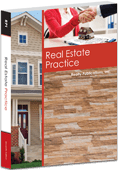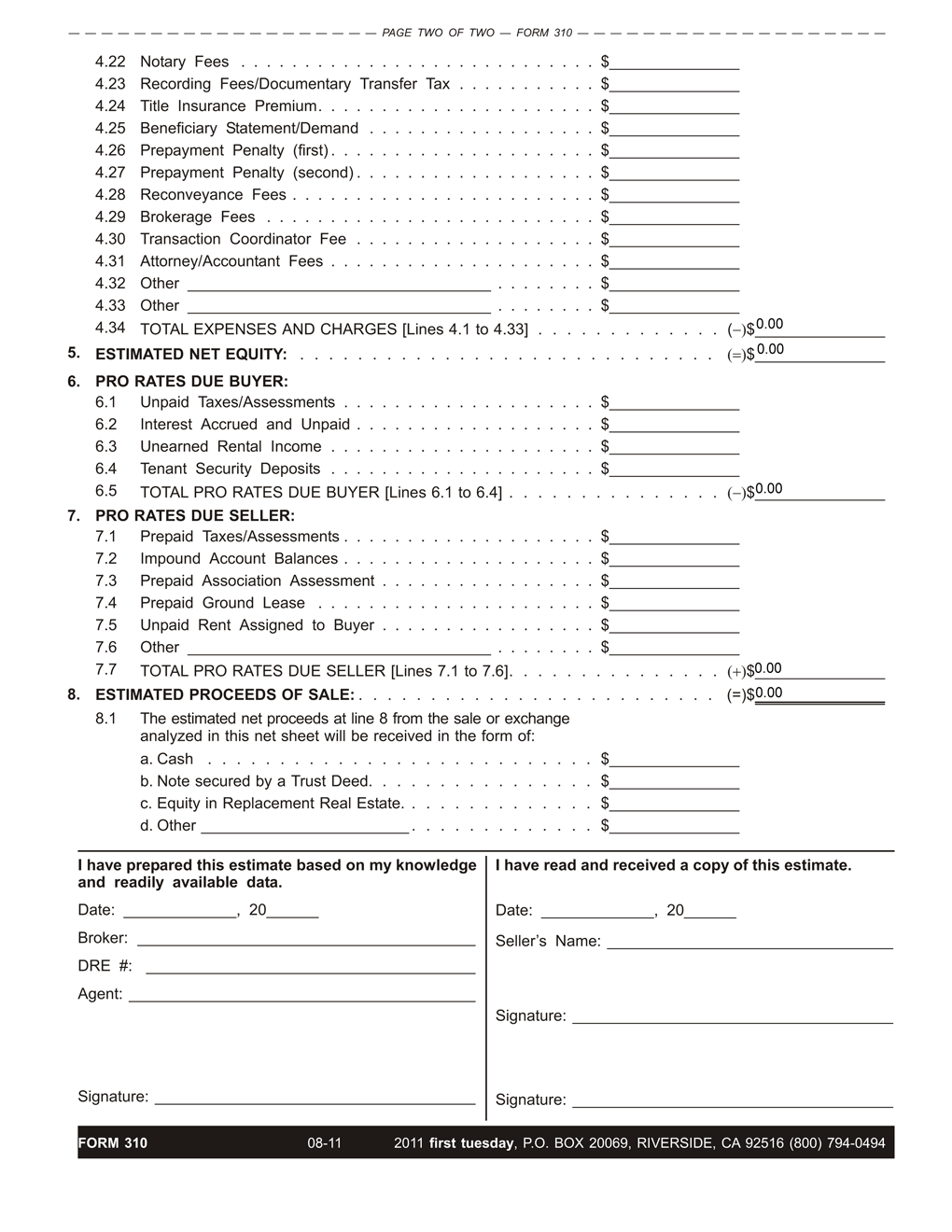The analysis of client transaction costs
The most pressing concern sellers have about the sale of their property is the amount of money they will receive on closing at the price offered by a buyer. Further, sellers know the net sales proceeds they receive on closing will not be the entirety of the price paid by the buyer for the property.
What sellers do not know is the net cash value of their equity in the property at the price before them — the net sales proceeds after debts and charges have been paid to clear title and close escrow. The amount they will receive in exchange for a deed to their property is naturally a material fact. This is the case in any sale, for any type of property and for any seller. Thus, to provide the net cash value of the seller’s equity in the property, the seller’s agent prepares and reviews a seller’s net proceeds disclosure form with the client. [See RPI Form 310]
Likewise, a buyer needs to bring together capital to purchase real estate. Essentially, they need access to cash to pay the price and associated costs of acquiring property. To document the cash a prospective buyer can gather from all their available sources to fund the purchase of a property, the buyer’s agent uses a parallel worksheet, called a buyer’s cost sheet.
The buyer’s cost sheet, as the name implies, is the other side of the transactional coin from the seller’s net sheet. [See RPI Form 311]
A reasonable estimate of costs for the seller
Sellers often do not feel comfortable asking their agent how much money they can expect to receive on the close of a sale. However, the serious nature of this unspoken concern is always present with a seller — it is of paramount concern. Sellers are primarily interested in what they will actually receive as the net sales proceeds for transferring ownership. This amount equals the net worth of their property and what they receive on its sale.
Most sellers do not know how to figure the dollar amount of net sales proceeds. A seller initially believes the net sales proceeds is roughly equal to their equity in the property — price minus debt, less a broker fee. Most sellers are not familiar with the cost of retrofitting property and complying with governmental safety regulations, as well as escrow and title fees, lender payoff charges and a buyer’s demands for repairs — until these costs are brought to their attention by their agent.
Further, the asking price is unadjusted for the need to fix up the property and clear it of structural pests and deferred maintenance to prepare it for marketing.
On the other hand, sellers’ agents have a vast knowledge of the expenses which confront a seller when they properly market, sell and close escrow on a property.
A reasonable estimate of the likely net sales proceeds on any sale is first prepared on a seller’s net sheet at the listing stage based on the asking price established by the seller with the counsel of their agent. It is again prepared when reviewing offers before acceptance or when updating the net sheet figures to reflect any change in the listed price. [See RPI Form 310]
A new or revised net sheet needs to be prepared with each new scenario. Thus, when presenting an offer to the seller, the seller’s agent prepares a net sheet to reflect the terms of the offer received. Further, when a counteroffer is prepared, a net sheet is also provided to show the seller what their net bottom line will be under the different terms of the counteroffer. [See RPI Form 180]
For a seller’s agent, some degree of risk accompanies the delivery of disclosures, including net sales figures. The information may cause a prospective seller to get cold feet while soliciting a listing or may cause a seller to reject an offer and counter at a preconceived price needed by the seller but unacceptable to a buyer. However, these seller pricing decisions illustrate the net sheet information is a material fact requiring an affirmative disclosure voluntarily undertaken by the seller’s agent.
The seller’s net sheet displays the seller’s bottom line on the sale of the property. Thus, a net sheet review with a seller is part of every competent listing presentation or purchase agreement offer submission for the sale of property. [See RPI Form 310]
Further, the time and effort expended to prepare a net sheet is a small premium to pay to assure the agreed fee is not disputed at the time of closing. [See RPI Form 310]
Related article:
Material facts and your opinions – liability exposure minimized
Analyzing the seller’s net sheet estimates
A seller’s agent prepares the Good Faith Estimate of Seller’s Net Sales Proceeds published by RPI (Realty Publications, Inc.) to inform their client about the expenses the seller will likely incur on the sale of their real estate. [See RPI Form 310]
The estimates entered on the form by the seller’s broker or agent are based on information known or readily available on the inquiry of others (escrow officers) or on minimal investigation about each item of expense they anticipate the seller will incur. Thus, the figures entered as estimates reflect the agent’s honestly held belief of the amounts likely to be experienced by the seller — they are not mere “guestimates.”
Brokerage events triggering an agent’s preparation of the net sheet and a review of its contents with the seller include:
- soliciting or entering into a seller’s listing agreement [See RPI Form 102];
- submitting a buyer’s purchase agreement offer [See RPI Form 150];
- preparing a counteroffer [See RPI Form 180]; and
- entering into an exchange agreement offer or acceptance. [See RPI Form 171]
Use of the seller’s net sheet
The net sheet is used by a seller’s agent for the purpose of disclosing to the seller the crucial financial information surrounding expenditures required to market the property for sale. This includes costs incurred to:
- bring the property to a physical condition that makes it attractive to the greatest number of prospective buyers, typically clearing out deferred maintenance (called fix-up costs);
- comply with local retrofitting ordinances and current safety standards;
- eliminate defects and pest infestation (which are often exposed in home inspection and pest control reports) [See RPI Form 130 and 132]; and
- provide the seller’s agent with reports for delivery to prospective buyers which contain information on the physical condition of the property, the natural hazards of the property’s location, the expenses of ownership and any other aspects regarding the integrity of the property that have a measurable impact on the property’s value. [See RPI Form 304, 314 and 310]
Related Video: The Standardized Inspection Report
Click here for more information on this topic.
The Good Faith Estimate of Seller’s Net Sales Proceeds form consists of four sections, each serving a unique purpose in setting the amount of net proceeds to be received by a seller on a sale. [See RPI e-book Real Estate Practice Chapter 37]
The sections list:
- the encumbrances of record, including any improvement district bonds, mortgages and possible abstracts of judgment or tax liens to be assumed, reconveyed or released [See RPI Form 310 §3];
- the expenses of a sale, including repair and renovation expenditures, fees for investigative reports, broker fees and closing charges paid by the seller [See RPI Form 310 §4];
- adjustments and prorates for unpaid or prepaid items and any tenant deposits to be taken over by the buyer [See RPI Form 310 §§6-7]; and
- the net proceeds remaining after deducting all sales-related expenses, fees and charges, as well as the form the net proceeds will take. [See RPI Form 310 §8]
The buyer’s acquisition costs and source of funds
The buyer’s cost sheet, on the other hand, is designed as a checklist for the buyer’s agent to identify and estimate in good faith the buyer’s costs of acquisition and financing, as well as the sources of the buyer’s funds. [See RPI Form 311]
The maximum price a prospective buyer is able to offer for a property is determined by the amount of available funds from all sources which remain after deducting the acquisition costs.
Before a cost sheet review with the buyer can go beyond identifying the various sources of cash available to the buyer, the buyer’s agent needs to arrange a meeting for the prospective buyer with a minimum of two mortgage lenders.
Having determined the prospective buyer’s costs of mortgage funding and the transactional charges they will likely incur to acquire a property, the buyer becomes certain about:
- the price they are willing to pay for a property; and
- the amount of upfront nonrecurring acquisition and financing costs will be incurred (and who will pay them).
What remains for the buyer’s agent to do is locate qualifying properties and write up a purchase agreement offer agreeable to the buyer on the most suitable property. [See RPI Form 150 and 311]
Related article:
California homebuyers think twice about high homeownership costs
Analyzing the buyer’s cost sheet estimates
Buyer’s brokers and their agents use the Good Faith Estimate of Buyer’s Acquisition Costs published by RPI to inform their buyer about the cost of acquiring a particular parcel of real estate they have located and have determined is suitable for acquisition by the buyer. [See RPI e-book Real Estate Practice Chapter 38]
The form contains a checklist of bookkeeping items typical of most purchases, including:
- acquisition costs;
- financing charges;
- prorations;
- funds required for acquisition; and
- the buyer’s probable sources of funds. [See RPI Form 311]
The estimates entered by the buyer’s agent need to be based on concrete information about transaction costs and finance charges both known to them or readily available on an inquiry of others or on minimal investigation. Thus, the figures entered reflect the agent’s honestly held belief that the estimated amount will likely be experienced by the buyer when the buyer acquires the property under consideration.
The cost sheet is used to disclose the crucial financial information the buyer needs to know about the acquisition of a property. With it, the buyer’s agent provides the buyer with a high level of transparency about the costs of acquisition. Thus, the prospective buyer is able to make an informed decision about the financial commitment needed to purchase the property. [See RPI Form 311]
Related Video: Estimates as Projections or Forecasts
Click here for more information on this topic.
Use of the buyer’s cost sheet
The events triggering the buyer’s agent’s preparation of a cost sheet and a review of the costs with the prospective buyer include:
- entering into a buyer’s listing agreement [See RPI Form 103];
- obtaining pre-approval for a mortgage; and
- entering into a purchase agreement offer or accepting a counteroffer. [See RPI Form 150 and 180]
The cost sheet is also used to solicit tenants — residential or commercial — to consider the purchase of property. With it, the agent demonstrates how the tenant has the financial capability to occupy a comparable property as an owner instead of as a tenant, be it a home or commercial/business premises. [See RPI Form 311]
Each section in the cost sheet has a separate purpose, which cover:
- the acquisition costs of the property (cost basis) [See RPI Form 311 §§2-6];
- the closing charges (including prorations and adjustments) [See RPI Form 311 §§7-10]; and
- the buyer’s source of funds (savings, gifts, mortgages, etc.). [See RPI Form 311 §11]
This article was originally published December 2015 and has been updated.
Want to learn more about the seller’s net sheet and buyer’s cost sheet? Click the image below to download the RPI book cited in this article.



















